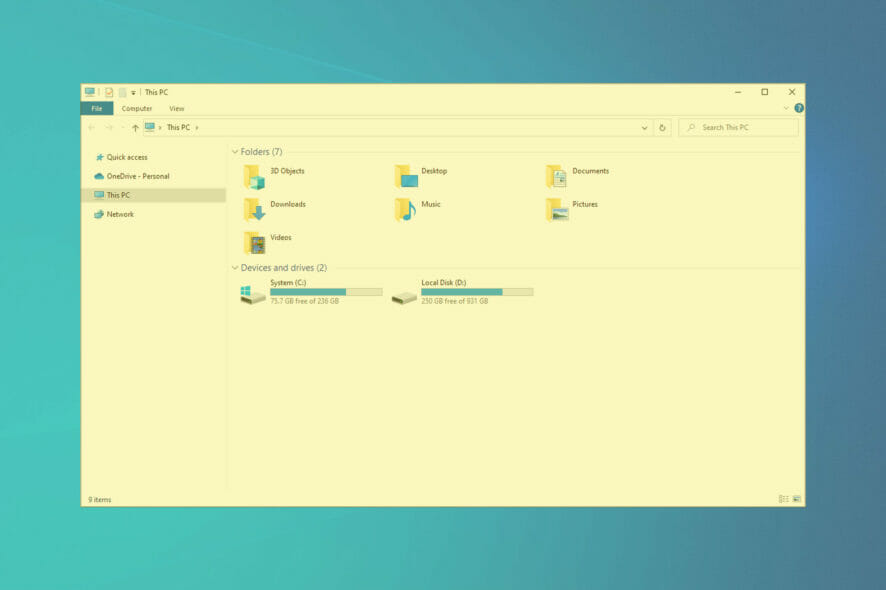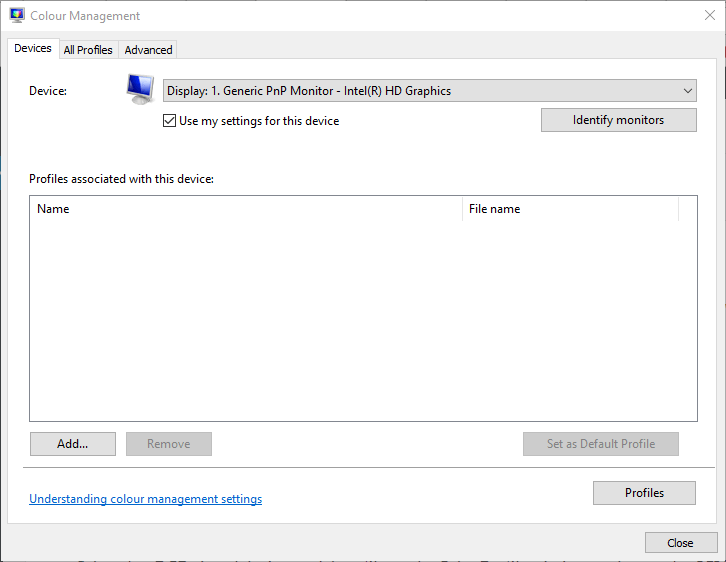How to Fix Yellow Screen Issues on Windows 10/11
A possible cause for the yellow screen are outdated drivers
4 min. read
Updated on
Read our disclosure page to find out how can you help Windows Report sustain the editorial team Read more
Key notes
- If your monitor has a yellow tint display after Windows 10 updates, know you are not the only one.
- If you are wondering how to fix it, keep on reading the guide below.
- We recommend taking a look at your lightning settings and adjusting the color enhancement settings.
- We also show you two ways to update your graphics card driver.

Some users have stated on forums that their monitors have a yellow screen after some Windows 10 updates. Does your VDU (Visual Display Unit) display a yellow screen?
If so, it could be a hardware issue, or you might just need to adjust some display settings in Windows. These are some Windows 10 resolutions that might fix yellow-screened VDUs.
One troublesome issue on all versions of windows is a Yellow Screen of Death, and this issue usually appears if you’re having driver or graphics card issues.
Sometimes you might get tinted screenshots on Windows, but that’s usually caused by additional apps that might be running in the background.
In case you’re getting vertical or horizontal lines on your screen, it’s possible that your graphics card is having some issues, so be sure to check it.
How can I fix the yellow screen in Windows 10?
- Switch off the night light setting
- Update the graphics card driver
- Add a new default color profile
- Adjust the color enhancement settings
- Check the VDU’s OSD color settings
1. Switch off the night light setting
- Press the Type here to search button on the Windows 10 taskbar.
- Enter the keyword display in Cortana’s search box.
- Select Change display settings to open the Settings window shown directly below.
- Toggle the Night Light option off if it’s on.
2. Update the graphics card driver
Numerous display issues can be fixed by updating the graphics card drivers so it might be worth checking to see if there’s a more updated graphics card driver. The quickest way to do that is to utilize driver updater software in Windows or use a dedicated third-party driver updater such as Outbyte Driver Updater.
Outbyte Driver Updater will help you update drivers automatically and prevent PC damage caused by installing the wrong driver versions. All the drivers that are being installed on your device are being tested for security and authority.
Outbyte Driver Updater scans your device really fast and once it detects an outdated driver it will update it. If you want to never worry about even getting to the point of having outdated drivers, then you can simply activate the auto driver update.
Outbyte Driver Updater has a large database of over 18 million driver files so it is almost certain that it will be able to find the right driver for all your hardware.
3. Add a new default color profile
- Enter the keyword color management in Cortana’s search box.
- Select Color Management to open the window in the snapshot directly below.
- Choose your VDU on the Device drop-down menu.
- Click the Use my settings for this device option.
- Press the Add button to open the window shown below.
- Select the sRGB virtual device model profile on the Color Profile window, and press the OK button.
- Then select the sRGB virtual device model profile on the Color Management window, and press the Set as Default Profile button.
4. Adjust the color enhancement settings
Your graphics card’s color settings might not be at their default configuration. If so, restoring color settings to default might fix a yellow screen. You can usually configure color settings with a graphics card’s configuration utility.
For example, to configure Intel color settings, you can right-click the desktop, and select Graphics Properties – Display and Color Enhancement to open the options shown directly below.
Look for similar options on NVIDIA and AMD control panels, and restore the color settings to default.
5. Check the VDU’s OSD color settings
Most desktop VDUs also include additional color control settings of some kind. Your desktop’s VDU might include contrast, gamma, hue, saturation, color temp, and color tint options on its OSD menu. So check how your monitor’s OSD color settings are configured and make the required adjustments.
Those are some of the resolutions that will probably get rid of the yellow screen. If you still can’t fix a monitor’s yellow screen, consider returning the VDU to the manufacturer for repairs if it’s still within a warranty period.
If you are interested in learning how to fix more Windows 10 errors, check our Troubleshooting Hub.












